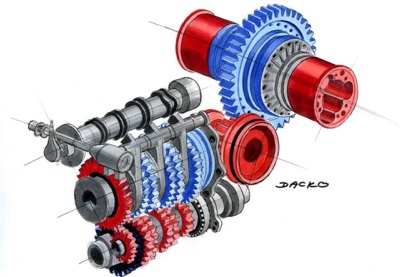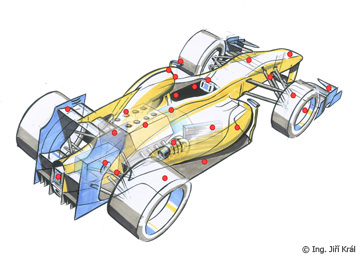Gearbox
Miroslav Sanytr├Īk | 11.2.08 | P┼Öevody
F1
The current F1 gearboxes are automatic sequential ones, which means that the driver can change gears at his own will but does not have to apply the clutch. Shifting can also be switched into the fully automatic mode. This option is especially used at long straights, where the exactly timed shifts bring the maximal acceleration. The shifting is iniciated by the paddles under the steering wheel, which means that the link with the gearbox is not mechanical but electronic. The electro-hydraulics system not only operates the clutch but also takes care of changing gears itself, according to the driverŌĆśs choice. There are several reasons for this concept. The gearbox takes an incredible stress and an incorrect shifting may damage it. Furthermore, due to the speed of shifting and stress load, they are designed without the usual synchronization. That is ensured by the electronics which tunes the engineŌĆśs and the gearbox shaftŌĆśs rpm into accordance before each change of gears. To do so, it uses for example the ignition or the choke in the intake manifold. The electronics is also a safety element, as it prevents changing into a gear that, at given rpm, would result into the damage to the gearbox. For example changing into the first gear at the top speed. Another reason for automated construction is reaching the shortest possible time of the gear change and removal of the mechanical link between the shifting element and the gearbox. Thanks to the electronic connection the shifting controler may be paddles or buttons on the steering wheel, whereas the steering wheel may be easy removed in case of a crash or mere getting in and out of the cockpit.
 |
The F1 gearboxes usually have six or seven gears, while the FIA regulations require at least four and at most seven gears. The design of the gearbox is also influenced by the fact, that is meant to be a bearing element of the rear suspension and consequently has to deal with shocks and a number of other stress load transferring them further onto the engine and the monocoque. Not only it must be firm, it also needs to be light and that is why the frequent material is magnesium alloy, carbon composite and exceptionally titanium. Because of strength, the box is made as one part, while the shafts with gears are inserted from the side that later fits onto the engine. The box is not closed in the rear part. The dividing line being the axis of the shaft of final gear. At the end of the gearbox, there is another part, which is angular to a great extent to copy the shape of the diffuser. The FIA requires having a rear gear, although, in reality, it has no practical use. This gear is therefore away from the main shafts. The gears are designed as individual cassettes or cartridges, that can be freely changed to set the best gearing for a specific circuit. To illustrate - all gears may be exchanged in 40 minutes.




